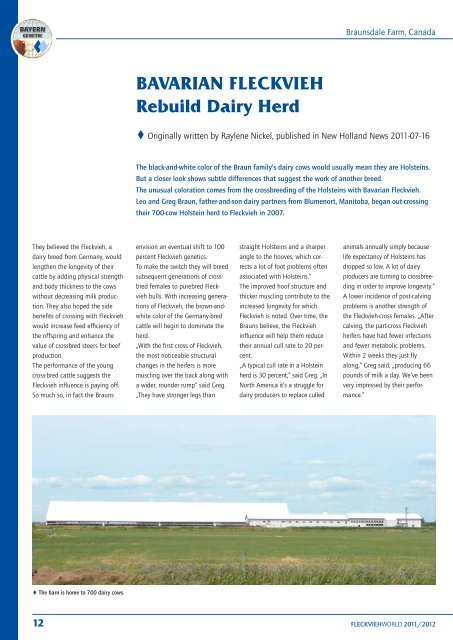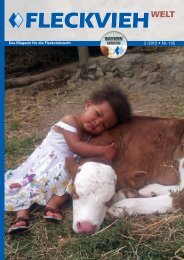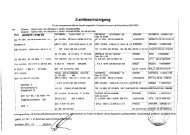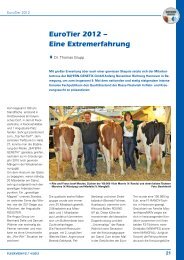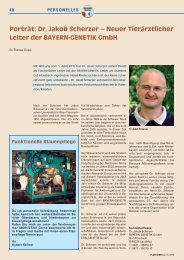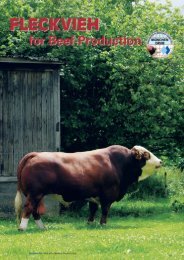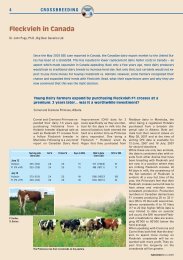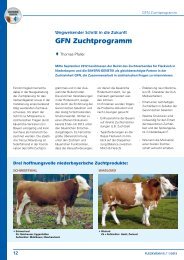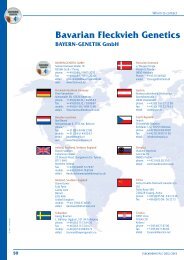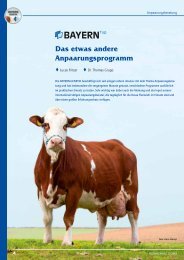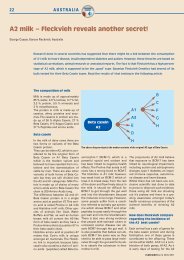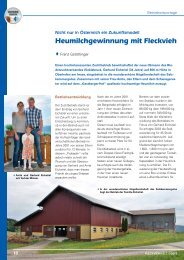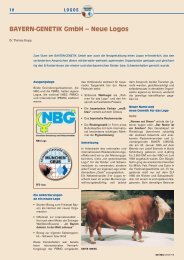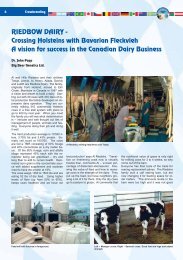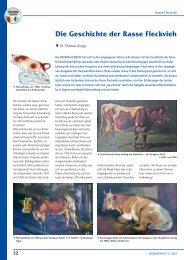BAVARIAN FLECKVIEH Rebuild Dairy Herd
BAVARIAN FLECKVIEH Rebuild Dairy Herd
BAVARIAN FLECKVIEH Rebuild Dairy Herd
You also want an ePaper? Increase the reach of your titles
YUMPU automatically turns print PDFs into web optimized ePapers that Google loves.
They believed the Fleckvieh, a<br />
dairy breed from Germany, would<br />
lengthen the longevity of their<br />
cattle by adding physical strength<br />
and body thickness to the cows<br />
without decreasing milk production.<br />
They also hoped the side<br />
benefits of crossing with Fleckvieh<br />
would increase feed efficiency of<br />
the offspring and enhance the<br />
value of crossbred steers for beef<br />
production.<br />
The performance of the young<br />
cross-bred cattle suggests the<br />
Fleckvieh influence is paying off.<br />
So much so, in fact the Brauns<br />
l The barn is home to 700 dairy cows.<br />
<strong>BAVARIAN</strong> <strong>FLECKVIEH</strong><br />
<strong>Rebuild</strong> <strong>Dairy</strong> <strong>Herd</strong><br />
Braunsdale Farm, Canada<br />
l Originally written by Raylene Nickel, published in New Holland News 2011-07-16<br />
The black-and-white color of the Braun family’s dairy cows would usually mean they are Holsteins.<br />
But a closer look shows subtle differences that suggest the work of another breed.<br />
The unusual coloration comes from the crossbreeding of the Holsteins with Bavarian Fleckvieh.<br />
Leo and Greg Braun, father-and-son dairy partners from Blumenort, Manitoba, began out-crossing<br />
their 700-cow Holstein herd to Fleckvieh in 2007.<br />
envision an eventual shift to 100<br />
percent Fleckvieh genetics.<br />
To make the switch they will breed<br />
subsequent generations of crossbred<br />
females to purebred Fleckvieh<br />
bulls. With increasing generations<br />
of Fleckvieh, the brown-andwhite<br />
color of the Germany-bred<br />
cattle will begin to dominate the<br />
herd.<br />
„With the first cross of Fleckvieh,<br />
the most noticeable structural<br />
changes in the heifers is more<br />
muscling over the back along with<br />
a wider, rounder rump“ said Greg.<br />
„They have stronger legs than<br />
straight Holsteins and a sharper<br />
angle to the hooves, which corrects<br />
a lot of foot problems often<br />
associated with Holsteins.“<br />
The improved hoof structure and<br />
thicker muscling contribute to the<br />
increased longevity for which<br />
Fleckvieh is noted. Over time, the<br />
Brauns believe, the Fleckvieh<br />
influence will help them reduce<br />
their annual cull rate to 20 percent.<br />
„A typical cull rate in a Holstein<br />
herd is 30 percent,“ said Greg. „In<br />
North America it’s a struggle for<br />
dairy producers to replace culled<br />
animals annually simply because<br />
life expectancy of Holsteins has<br />
dropped so low. A lot of dairy<br />
producers are turning to crossbreeding<br />
in order to improve longevity.“<br />
A lower incidence of post-calving<br />
problems is another strength of<br />
the Fleckvieh-cross females. „After<br />
calving, the part-cross Fleckvieh<br />
heifers have had fewer infections<br />
and fewer metabolic problems.<br />
Within 2 weeks they just fly<br />
along,“ Greg said, „producing 66<br />
pounds of milk a day. We’ve been<br />
very impressed by their performance.“<br />
12 <strong>FLECKVIEH</strong>WORLD 2011/2012
Braunsdale Farm, Canada<br />
The Brauns have found calving<br />
ease of the Fleckvieh crossbreds to<br />
be similar to that of their Holsteins.<br />
The disposition of the Fleckvieh<br />
tends to be calmer and more<br />
confident. Their milk tends to have<br />
a higher protein and butterfat<br />
content than that of Holsteins.<br />
Feed savings is yet another benefit<br />
of crossing with Fleckvieh. While<br />
developing the first generation of<br />
crossbred heifers, the Brauns fed<br />
Fleckvieh crossbreds and purebred<br />
Holstein heifers in the same<br />
groups. They saw significant differences<br />
in performance between<br />
the two types of cattle.<br />
„The Fleckvieh crosses out-performed<br />
the Holsteins by half a score,<br />
in terms of maintaining body<br />
condition,“ said Greg. „Across the<br />
board we’ve experienced a 20<br />
percent reduction in the amount<br />
of grain we feed to our young<br />
stock. We saw that the crossbreds<br />
were able to maintain and grow<br />
with less grain than the Holsteins.<br />
We’ve had to pull back on the<br />
amount of grain in our heifer<br />
rations.“<br />
The increased feeding efficiency of<br />
Fleckvieh cattle offers potential<br />
for increasing earnings from<br />
l The milking house of the braun family.<br />
steers. When the Brauns produced<br />
straight Holstein cattle, they<br />
found that their Holstein bull<br />
calves had little value when sold<br />
either as young calves or heavier<br />
steers headed to feedlots. Commercial<br />
feeders typically sidestep<br />
Holsteins because of reduced feed<br />
efficiency.<br />
The Fleckvieh-cross steers promise<br />
a different feeding scenario.<br />
Last year the Brauns experimented<br />
with the feeding of a small<br />
group of crossbred steers. They<br />
fed the steers to finish weights<br />
of 1400 to 1500 pounds at 15<br />
to 17 months and marketed<br />
them directly to a processing<br />
plant.<br />
„The performance of the steers<br />
looks promising,“ said Greg. „It<br />
appears that they can gain<br />
weight like any other beef breed.<br />
We see a lot of potential for<br />
Fleckvieh steers to create additional<br />
income for our farm.“<br />
The enhanced feeding efficiency<br />
of the Fleckviehs appears to<br />
contribute to their ability to do<br />
well on a high-forage ration. The<br />
Brauns saw this in the young<br />
stock grazing grass in the summer.<br />
„The Fleckvieh-cross cattle<br />
l Leo and Greg Braun, father-and-son dairy partners from Blumenort, Manitoba.<br />
seem better able to maintain<br />
themselves on grass than the<br />
Holsteins,“ said Greg. „I think<br />
they would be a good fit for a<br />
dairy operation dependent on<br />
grazing cows in the summer.“<br />
In the Braun’s confinement facilities<br />
for cows, grazing plays a<br />
minor role. High forage rations<br />
for indoor feeding offer future<br />
efficiencies for reducing feed<br />
costs. Having cows that thrive on<br />
forage is the key to realizing<br />
these efficiencies.<br />
„Part of our goal is to improve<br />
the forage crops on our farm and<br />
increase the amount of forage<br />
we feed,“ said Greg. „In other<br />
words, we’re trying to get more<br />
milk out of the forages we grow<br />
on our own land. Because we<br />
buy all of the grain that we feed,<br />
the possibility of getting more<br />
milk out of forage holds economic<br />
promise for us, especially as<br />
grain prices go higher.“<br />
The Brauns produce forage crops<br />
on 2,000 acres, growing alfalfa,<br />
<strong>FLECKVIEH</strong>WORLD 2011/2012 13
l The cows are milked with a rotary milking parlour.<br />
l The calf barn of Braunsdale farm.<br />
barley, and Italian ryegrass. They<br />
harvest as haylage, the barley,<br />
ryegrass, and 90 percent of the<br />
alfalfa. The remaining alfalfa is<br />
baled for dry hay to feed young<br />
stock.<br />
The Italian ryegrass is a biennial<br />
that does not produce a seed in<br />
the first year. The Brauns establish<br />
new crops of ryegrass annually.<br />
„We get a good leafy plant yielding<br />
high quality haylage,“ said<br />
Greg. „But the crop likes to have<br />
moisture.“ With average growing<br />
conditions the ryegrass yields 6<br />
to 8 tons of haylage per acre. The<br />
ryegrass haylage contains 16 to<br />
20 percent protein, depending<br />
on stage of harvesting. It has a<br />
digestibility similar to other<br />
grasses. „Like other grasses it has<br />
good sugar levels to support<br />
rumen activity,“ said Greg.<br />
To plant and harvest the forage<br />
crops they engage custom operators.<br />
That frees the Brauns and<br />
their 10 full-time employees to<br />
focus their energies on managing<br />
the dairy cattle and facilities.<br />
The Brauns’ evolution to the<br />
Fleckvieh breed began with<br />
careful research. They visited a<br />
handful of dairy producers in<br />
Canada which had already been<br />
crossing their Holsteins with<br />
Fleckvieh.<br />
„These farmers told us their vet<br />
bills decreased when they stared<br />
crossbreeding, and the longevity<br />
of their cows increased,“ said<br />
Greg.<br />
Their research of Fleckvieh cattle<br />
also took them to Germany<br />
where purebred Bavarian Fleckvieh<br />
cows made up the milking<br />
herds. Like the Brauns’ own herd,<br />
the German cows they saw were<br />
fed and managed in confinement<br />
facilities.<br />
In the herds they visited, average<br />
annual milk production was<br />
around 22’000 pounds per<br />
cows. They found healthy, productive<br />
cows as old as 8 to 12<br />
years of age.<br />
„It was an eye-opening experience<br />
and changed the way I<br />
look at dairy cattle,“ said Greg.<br />
„In North America we have a<br />
certain type of animal in mind<br />
when we envision a dairy cow.<br />
We tend to expect a body that is<br />
sharp and edgy. But to see the<br />
success the German producers<br />
were having with these roundbodied,<br />
dual-purpose cows that<br />
could produce both milk and<br />
beef literally changed the way I<br />
look at cattle.“<br />
The Brauns returned home from<br />
Germany determined to completely<br />
overhaul the genetics of<br />
their herd, beginning by breeding<br />
every cow to a Fleckvieh<br />
sire. „We were truly impressed<br />
with what we had seen, and we<br />
were quite comfortable in thinking<br />
we could get both milk and<br />
beef from the same breed. We<br />
thought we had everything to<br />
gain and nothing to lose by<br />
switching to Fleckvieh.“<br />
Braunsdale Farm, Canada<br />
To start their crossbreeding they<br />
bought frozen semen from purebred<br />
Fleckvieh sires. The genetics<br />
are handled by supplier Dr. John<br />
Popp, Erickson, Manitoba. Popp,<br />
also a beef producer, owns Big<br />
Bear Genetics and specializes in<br />
Fleckvieh genetics and dairy<br />
nutrition.<br />
His company introduced Bavarian<br />
Fleckvieh genetics to North<br />
American dairy producers when<br />
10 years ago he and his late<br />
father began sourcing semen<br />
from high-quality Fleckvieh sires<br />
in Germany. Big Bear Genetics<br />
also offers frozen embryos of<br />
full-blood Bavarian Fleckvieh<br />
breeding.<br />
The Bavarian Fleckvieh is a distinct<br />
dairy breed separate from<br />
the beef strain of Fleckvieh more<br />
commonly found in North American<br />
herds. Both strains originate<br />
from the Simmentaler breed of<br />
cattle.<br />
The Brauns have introduced<br />
Fleckvieh genetics into their herd<br />
by several means. They’ve bred<br />
cows by artificial insemination,<br />
purchased frozen embryos, and<br />
bought purebred sires derived<br />
from German embryos from Big<br />
Bear Genetics.<br />
„The genetics of the sires we use<br />
are all above average,“ said<br />
Greg. „We look for sires proven to<br />
have the genetics for good milk<br />
production, with strong feet and<br />
legs, and well-conformed udders<br />
in the females. We believe Fleckvieh<br />
dairy cattle offer a lot of<br />
advantages, especially in places<br />
and during times when the price<br />
of milk is low,“ he said. „Producers<br />
can always fall back on the<br />
animals’ beef production as an<br />
additional source of income<br />
along with the animals’ ability to<br />
utilize forages more effectively.“<br />
14 <strong>FLECKVIEH</strong>WORLD 2011/2012<br />
l


